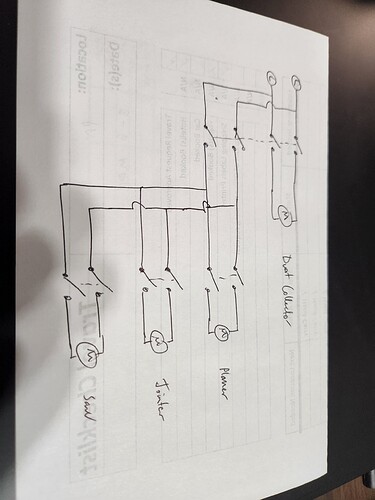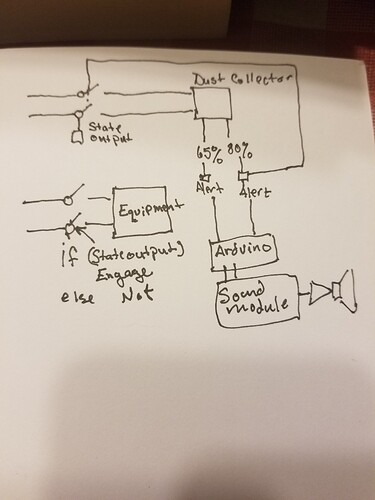Exactly.
You guys are sadistic AF
perhaps a weight sensor on the dust can? The lights flash on and off in the room and the voice of darth vadar stating “you have failed me for the last time, now empty the dustcan”
I’ve got a 12v revolving red light (gumball machine, in old police car terminology) that I’d contribute to the project. Might also have a Federal police car siren around here somewhere…

The light is something like this, just smaller.
While we’re dreaming big why not just make it go dump itself when it’s full. Cut a hole in the wall build a box with a door to the outside.When the barrel is full, trigger it to shut the room down. Make a laser guided path to the dumpster. Have a robotic arm that can open the dumpster and empty the barrel. Then return itself to the box and power up the room again. Problem solved.
If that’s to much
You’re MakeICT address good or just post them here for everyone enjoyment?
… so make an autonomous battlebots chassis that has a pneumatic ram that launches the dust into the trash bin and all points around.
I think it’s doable.
Either. I ordered a module and I have a spare arduino.
This would work better.
Replacing the initial set of switches with a pair of contactors would add a measure of safety, though I know the jointer already has a magnetic switch. I don’t recall if the planer does or not. And of course, the sawstop has a micro-controller or micro-processor protecting it.
However, a second advantage of using a pair of contactors is that a low voltage could also control them as long as the coil voltage is selected correctly. That means that a remote control system can still be used.
Yet a third advantage is that contactors can be relatively inexpensive compared to comparable high current switches like those needed for 15 or 20 amp circuits. Thus, it is easier to oversize them to reduce the chance of welding the contacts of a switch closed.

It is also a good idea to break both legs of the 220V powering these machines, which means either a DPST switch or at least a 2P contactor.
I would slave the individual machines’ contactors to the one powering the dust collector, but I need to think on this a bit more, as we don’t want somebody turning off the dust collector and that shutting down another machine in use.
Basically, no affected machine should turn on unless the dust collector is on, but the dust collector should not shut off unless all machines are off.
You just triggered my PTSD
Awesome! You are right. I work too much with low voltage.
I think we are leaning tward a plcc that has a bit of logic. So when we turn on the equipment it checks to see if the dust collector is on. If it’s on it turns on, if not it doesn’t turn on. The dust collector sings Henry the eighth over and over at 65% and at 80% switches to Gilbert godfied standup routines at 110db, and shuts down the dust collector.
If you have equipment on it won’t shut off, but it won’t turn back on. Could probably handle the whole thing on one arduino TBH. Though there is a part of me that wants to do the whole thing with analogue and logic chips.
Don’t let me do that. I have a spare nano, and a sound module on the way. We will need to spec out some relays or controllable breakers.
I’m not the most familiar with woodshop equipment, could you give an example of how shutting a tool down while in use would be dangerous to the operator? As far as ruining a workpiece I can definitely understand that, but if someone is continuing to use equipment for an extended period of time with the dust collector warning going off I’d say they brought that on themselves. I’d prefer to protect the equipment over the workpiece of someone who is neglecting the equipment. It certainly wouldn’t be worth risking the safety of the operator, though.
False positives would be much less likely with this than with the SawStop. That is an operator safety mechanism so they have to err well on the side of caution in their design, and it only has a fraction of a second to make a decision. False positives are far preferred over false negatives if appendages are on the line. For something like this you could easily add logic that would prevent the equipment from shutting off without adequate warning. Obviously if you don’t want to do it that’s fine, I think what you have planned will have good results. Just throwing in my thoughts for whatever they are worth.
See, you guys know this stuff. I had no idea Black Walnut had that compound in it, now I do. Interesting! Another piece of random facts stored in my memory bank. My idea could still be applied with other types of woods though, maybe when good wood shavings pile up they could be used in Positive ways like the examples above. I know we have people who raise chickens that might be interested. I am just naturally a person who tries to think of ways to put everything to use with little to no waste. LOL Years of Single parenting on a budget will do that to you.
The slave contactors, with more than one pole could be configured to be latching on so that removing power from the dust collector doesn’t kill the power to the other equipment. But, that does allow someone to run the dust collection, turn on the other equipment and then intentionally shut off the dust collection.
Also, it’s a minor modification to your schematic to use the separate existing circuit breakers for the other equipment rather than having everything supplied by the one pair of dust collection breakers.
You are correct that my schematic didn’t include use of the the individual circuits. But as mentioned, using contactors in this manner allows them to be fed from individual breakers but controlled from a central controller.
@Christian @mikeb @whateg01 @james.a.seymour @MAtherton
Can we meet on Maker Monday July 11th after the Leads Meeting and discuss this?
As woodshop lead I know how I will want these safeguards to operate, and would love to draw on your experience IRT. If we can hash out a plan I’ll be prepared to make purchases and this can be implemented post haste.
Post Script: potential undue risk to operators is very slight and mostly involves using very small or very heavy items on the jointer. Although any unexpected behavior from tools poses some increased risk.
Based on my current physical condition there’s about a 20% chance of being able to leave the house on any given day. And a 100% chance that I won’t know more than an hour ahead of time.
And if/when I go somewhere I can’t know in advance how long I’m good for.
So, all I can possibly promise is to contribute other than in person in whatever way seems constructive.
Mike
I should be able to be there.
I have the sound module in, I need MP3s to put on it. I can have about 256 of them… maybe less there is only 32G of space…
I figure we can have vectors that are a kind of sound byte. Like 100 mp3s of various ways of it telling you to empty it. Another 100 mp3s of it telling you it can’t come on because its full.
Then it just picks a random one out of that vector of 100.
I’m making a Similar system for my desk for frequently answered questions.
Better Suggestion: Do a weight sensor on the bin. Have it trigger a delayed shutdown. Say 2;00 am after the bin is half or 2./3 full. Use weight as a limit, it will be easier to empty. Many of those using the woodshop are old enough to not want to lift the bin that is full.
John
That’s the whole point of the “Empty at this line” thing. I disagree with the trigger beginning in the middle of the night. A user might fill half the barrel “finishing” up their project, leaving a completely full barrel to be emptied by the next unsuspecting user. It should alert the user(s) as soon as it reaches that point and the next time all using machines are off, it should keep them off until it is emptied.

